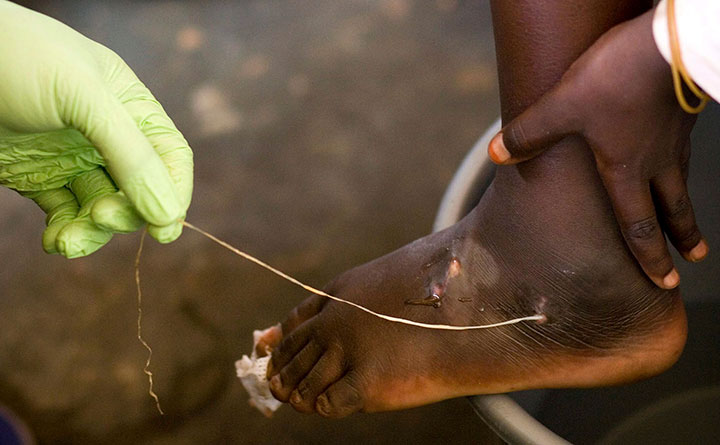A parasitic worm that can grow to be a metre long inside its human host, causing a crippling disease, is closer to being eradicated.

According to the World Health Organization (WHO), dracunculiasis, which is more commonly known as Guinea-worm disease, is closer to being eliminated from the planet. The disease affected more than 3.5 million people at its peak some 30 years ago.
Contracted by drinking infected water, Guinea worm disease affects some of the world’s most vulnerable people. The metre-long thread-like worm is asymptomatic and incubates in people for up to a year before painfully emerging, often through extremely sensitive parts of the body.
READ MORE: Jimmy Carter asks for money to get rid of guinea worm, UK promises millions if others donate
According to WHO, the worm is exclusively transmitted when people drink from stagnant water sources “contaminated with parasite-infected water fleas.”
During the mid-1980s, Guinea-worm disease was prevalent in 20 countries, 17 of which are located in Africa. Since then, eradication efforts have dropped reported cases at a steady rate. According to WHO, only 25 cases of the paralyzing disease were reported worldwide in 2016. The cases were reported in Chad, South Sudan and Ethiopia.

The Carter Center, the non-profit founded by former U.S. president Jimmy Carter, and one of the organizations leading global eradication efforts against Guinea-worm disease, said there were 30 cases reported in 2017, in isolated areas of Ethiopia and Chad.

Get weekly health news
On Wednesday, South Sudan announced the country had gone 15 months without a single reported case, suggesting a major victory for global health officials trying to eliminate the disease.
“To us as South Sudanese, we feel we have contributed to the common cause of humanity today, that we have played our part in realizing the dream of ridding the world of this debilitating disease,” Dr. Riek Gai Kok said in announcing transmission had been stopped in his country.
Infection and life cycle
As WHO notes, around a year after the initial infection, a painful blister begins to form, usually on the lower part of the leg. Then the worm (sometimes multiple worms) begin to emerge from the blister, causing a burning sensation. To help soothe the burning sensation, patients would often soak the infection in water, allowing the worm(s) to release thousands of baby worms into the water. The infected worms are then consumed by water fleas which are then swallowed by humans in drinking water.

According to the global health agency, the water fleas die in their host stomach, releasing the infected baby worms, which then move into the host’s body through the walls of the intestine. A fertilized female worn, which can reach a metre in length, makes its way under the host’s skin tissue, looking for an exit point, resulting in the blister and burning sensation, a process that can take up to 14 months.
READ MORE: Deadly measles outbreak spreads in Europe as vaccinations fall
South Sudan was one of nine countries still affected when its eradication program began in 2006. At the time, the disease was endemic in more than 3,000 villages, and the country tallied more than 20,500 cases.
Carter released a statement this week, noting the eradication process in South Sudan.
“South Sudan’s success shows that people can collaborate for the common good,” the former president said. “We are within reach of a world free of Guinea worm disease.”
Smallpox remains the only human disease to be successfully eradicated from the planet.
–with files from the Associated Press








Comments